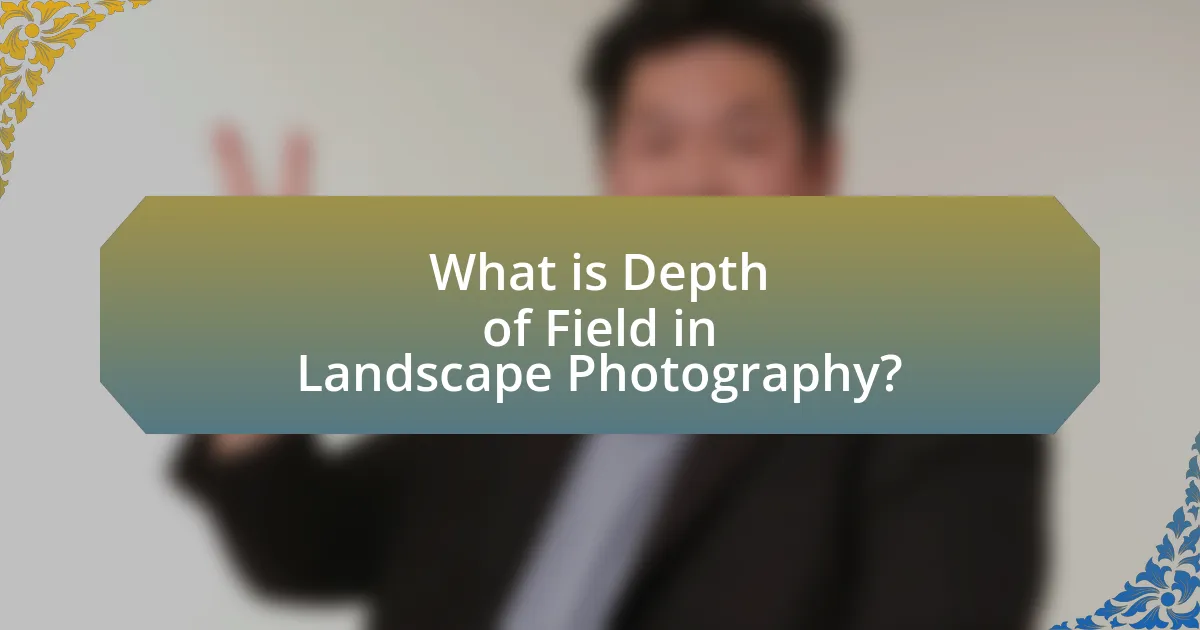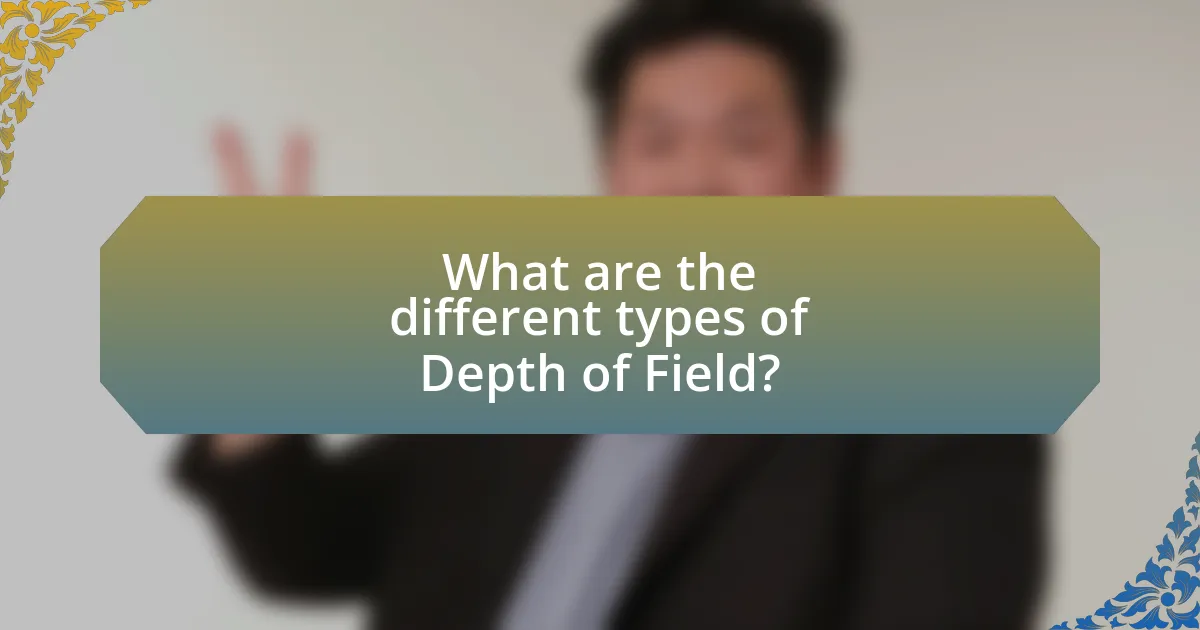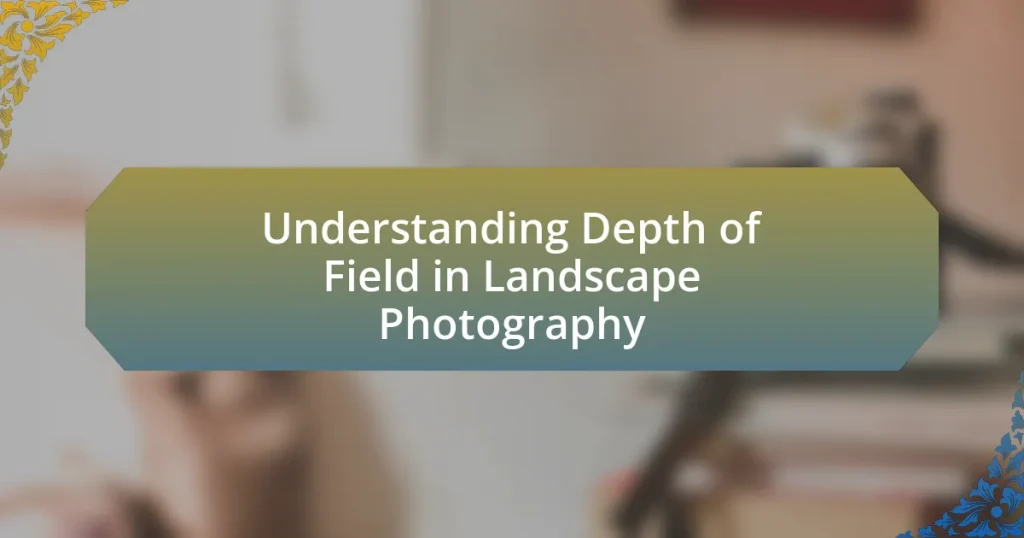Depth of Field (DoF) in landscape photography is the range of distance within an image that appears acceptably sharp, crucial for capturing both foreground and background elements in focus. This article explores how DoF influences landscape images, the key factors determining it, and the impact of aperture size and focal length on achieving desired sharpness. It also discusses the importance of DoF in composition and storytelling, the different types of DoF, and practical techniques for managing it effectively. Understanding these concepts is essential for landscape photographers aiming to enhance image quality and viewer engagement.

What is Depth of Field in Landscape Photography?
Depth of field in landscape photography refers to the range of distance within a photo that appears acceptably sharp. This concept is crucial for landscape photographers, as it allows them to capture both foreground and background elements in focus, enhancing the overall composition. A greater depth of field is typically achieved by using a smaller aperture (higher f-stop number), which increases the sharpness across various distances. This technique is supported by the physics of light and lens optics, where a smaller aperture reduces the amount of light entering the lens, resulting in a wider zone of focus.
How does Depth of Field influence landscape images?
Depth of Field (DoF) significantly influences landscape images by determining the extent of the scene that appears in focus. A greater DoF allows for more elements within the landscape, from foreground to background, to be sharp and clear, enhancing the overall detail and depth of the image. For instance, using a small aperture (high f-stop number) increases DoF, which is commonly employed in landscape photography to capture expansive vistas with clarity throughout. This technique is supported by the principle that a wider focus range contributes to a more immersive experience for the viewer, as it replicates the way the human eye perceives depth in a natural setting.
What are the key factors that determine Depth of Field?
The key factors that determine Depth of Field (DoF) are aperture, focal length, and distance to the subject. Aperture, measured in f-stops, directly influences DoF; a larger aperture (smaller f-number) results in a shallower DoF, while a smaller aperture (larger f-number) increases DoF. Focal length also plays a critical role; longer focal lengths produce a shallower DoF compared to shorter focal lengths at the same aperture and subject distance. Lastly, the distance to the subject affects DoF; as the distance increases, DoF becomes deeper. These relationships are supported by the principles of optics, where the circle of confusion and lens characteristics dictate the perceived sharpness in an image.
How does aperture size affect Depth of Field?
Aperture size directly influences depth of field, with larger apertures (smaller f-stop numbers) resulting in a shallower depth of field, while smaller apertures (larger f-stop numbers) create a deeper depth of field. This relationship occurs because a larger aperture allows more light to enter the lens, which reduces the area in focus, isolating the subject from the background. Conversely, a smaller aperture increases the range of distances that appear sharp, making it ideal for landscape photography where detail across the entire scene is desired. This effect is supported by the principles of optics, where the circle of confusion becomes larger with wider apertures, leading to a blurred background, while smaller apertures minimize this blur, enhancing overall sharpness in the image.
Why is Depth of Field important for landscape photographers?
Depth of Field (DoF) is crucial for landscape photographers because it determines the extent of the scene that appears sharp and in focus. A greater depth of field allows photographers to capture both foreground and background elements clearly, which is essential in landscape photography where expansive scenes are common. For instance, using a smaller aperture (higher f-stop number) increases DoF, enabling sharpness from the nearest foreground object to distant mountains or skies. This technique is supported by the principle that landscapes often require a wide focus range to convey depth and detail, enhancing the overall composition and viewer engagement.
How does Depth of Field contribute to composition?
Depth of Field (DoF) significantly contributes to composition by controlling the focus and clarity of elements within a photograph. A shallow DoF isolates the subject from the background, drawing attention to it and creating a sense of intimacy, while a deep DoF ensures that both foreground and background elements are in focus, enhancing the overall context and storytelling of the landscape. This technique allows photographers to guide the viewer’s eye and emphasize specific aspects of the scene, thereby influencing the emotional impact and narrative conveyed through the image.
What role does Depth of Field play in storytelling through images?
Depth of Field (DoF) significantly influences storytelling in images by controlling the focus and clarity of subjects within a scene. A shallow DoF isolates the main subject, drawing the viewer’s attention and creating emotional impact, while a deep DoF encompasses a broader range of elements, providing context and depth to the narrative. For instance, in landscape photography, a deep DoF can reveal intricate details in both foreground and background, enhancing the story of the environment, whereas a shallow DoF can evoke intimacy or highlight specific features, guiding the viewer’s interpretation. This technique is supported by the fact that photographers often use DoF to manipulate viewer perception, as evidenced by studies showing that images with intentional focus choices lead to varied emotional responses from audiences.

What are the different types of Depth of Field?
The different types of Depth of Field (DoF) are shallow depth of field, deep depth of field, and variable depth of field. Shallow depth of field occurs when only a small part of the image is in focus, often used to isolate subjects from their background. Deep depth of field ensures that a larger portion of the scene is in focus, which is commonly utilized in landscape photography to capture expansive views. Variable depth of field refers to the ability to adjust the focus plane dynamically, allowing for creative control over which elements are sharp or blurred in an image. These distinctions are crucial for photographers to achieve desired artistic effects and compositional clarity.
How do shallow and deep Depth of Field differ?
Shallow depth of field (DoF) results in a narrow focus area, blurring the background and foreground, while deep depth of field provides a wide focus area, keeping both foreground and background sharp. Shallow DoF is often used in portrait photography to isolate subjects, whereas deep DoF is preferred in landscape photography to capture detailed scenes from foreground to background. This difference is primarily influenced by aperture settings; a wider aperture (lower f-stop number) creates shallow DoF, while a smaller aperture (higher f-stop number) achieves deep DoF.
What are the visual effects of shallow Depth of Field in landscapes?
Shallow Depth of Field (DoF) in landscapes creates a pronounced separation between the subject and the background, resulting in a blurred background while keeping the subject in sharp focus. This effect emphasizes the subject, drawing the viewer’s attention directly to it, while the out-of-focus areas enhance the aesthetic appeal by adding a sense of depth and dimension. Studies in photography indicate that shallow DoF can evoke emotional responses by isolating the subject, making it more impactful. For instance, a photograph of a flower in a field with a blurred background can create a more intimate and engaging composition, as supported by the principles of visual perception in art and photography.
When should a photographer use deep Depth of Field?
A photographer should use deep depth of field when capturing landscapes to ensure that both the foreground and background are in sharp focus. This technique is essential for landscape photography as it enhances the overall composition, allowing viewers to appreciate the details throughout the scene. Deep depth of field is typically achieved by using a small aperture (high f-stop number), which increases the range of distances that appear sharp. This approach is supported by the fact that landscapes often contain multiple elements at varying distances, and maintaining clarity across these elements is crucial for conveying the scene’s depth and richness.
What is the relationship between Depth of Field and focal length?
The relationship between Depth of Field (DoF) and focal length is that as the focal length of a lens increases, the Depth of Field decreases. This means that longer focal lengths result in a shallower DoF, making it easier to isolate subjects from the background. Conversely, shorter focal lengths provide a greater DoF, allowing more of the scene to be in focus. This relationship is crucial in landscape photography, where the choice of focal length directly impacts the composition and clarity of the image.
How does focal length impact Depth of Field in landscape photography?
Focal length significantly impacts Depth of Field (DoF) in landscape photography by determining the extent of the area in focus. A longer focal length results in a shallower DoF, meaning that less of the scene will be in sharp focus, while a shorter focal length increases the DoF, allowing more of the landscape to appear sharp. For instance, using a 24mm lens (short focal length) can yield a greater DoF compared to a 200mm lens (long focal length), which typically isolates subjects and blurs the background. This relationship is crucial for landscape photographers aiming to capture expansive scenes with clarity throughout.
What are the implications of using wide-angle versus telephoto lenses?
Wide-angle lenses capture a broader field of view, making them ideal for landscape photography as they emphasize depth and spatial relationships. In contrast, telephoto lenses compress distances and isolate subjects, which can create a more intimate perspective but may reduce the sense of depth in a landscape. The choice between these lenses affects composition, depth of field, and the overall narrative of the photograph. For instance, wide-angle lenses typically have a greater depth of field, allowing more elements to be in focus simultaneously, while telephoto lenses often produce a shallower depth of field, which can highlight specific details but may blur the background.

How can photographers effectively manage Depth of Field?
Photographers can effectively manage Depth of Field (DoF) by adjusting aperture settings, focal length, and subject distance. A smaller aperture (higher f-stop number) increases DoF, allowing more of the scene to be in focus, which is crucial in landscape photography where detail across the frame is often desired. For instance, using an aperture of f/16 or f/22 can yield a greater DoF compared to f/2.8. Additionally, using a wider focal length (e.g., 24mm) enhances DoF compared to a longer focal length (e.g., 200mm) at the same aperture. Furthermore, positioning the camera closer to the subject can also increase DoF, as the hyperfocal distance technique allows photographers to maximize the range of acceptable sharpness. These methods are supported by the principles of optics, which dictate that aperture size, focal length, and distance to the subject directly influence the extent of focus in an image.
What techniques can be used to achieve desired Depth of Field?
To achieve the desired Depth of Field (DoF) in landscape photography, photographers can utilize techniques such as adjusting aperture settings, manipulating focal length, and altering the distance to the subject. Specifically, using a smaller aperture (higher f-stop number) increases the DoF, allowing more of the scene to be in focus. For instance, an aperture of f/16 or f/22 is commonly used for landscapes to ensure sharpness from foreground to background. Additionally, using a wider focal length (e.g., 24mm) enhances DoF compared to longer focal lengths (e.g., 200mm), as wider angles naturally capture more of the scene in focus. Furthermore, positioning the camera closer to the subject can also increase the DoF, as it allows for more elements within the frame to remain sharp. These techniques are supported by the principles of optics, where aperture size, focal length, and subject distance directly influence the extent of focus in an image.
How does hyperfocal distance help in landscape photography?
Hyperfocal distance helps in landscape photography by maximizing the depth of field, ensuring that both foreground and background elements are in sharp focus. When a photographer sets their lens to the hyperfocal distance, everything from half that distance to infinity appears acceptably sharp, which is crucial for capturing expansive landscapes. This technique allows photographers to create images with greater detail and clarity across the entire scene, enhancing the overall composition. Studies in photography emphasize that understanding and utilizing hyperfocal distance can significantly improve the quality of landscape images by effectively managing focus and depth.
What are the best practices for focusing in landscape photography?
The best practices for focusing in landscape photography include using a small aperture, focusing one-third into the scene, and utilizing hyperfocal distance. A small aperture, such as f/8 to f/16, increases depth of field, ensuring more of the scene is in focus. Focusing one-third into the scene optimizes sharpness across the foreground and background. Hyperfocal distance, the closest distance at which a lens can be focused while keeping objects at infinity acceptably sharp, can be calculated based on the aperture and focal length, allowing photographers to maximize depth of field effectively. These techniques are widely recognized in photography literature, such as “Understanding Exposure” by Bryan Peterson, which emphasizes the importance of depth of field in achieving sharp landscape images.
What common mistakes should photographers avoid regarding Depth of Field?
Photographers should avoid the mistake of not understanding the relationship between aperture, focal length, and distance to the subject when managing Depth of Field. This misunderstanding can lead to images that either lack sharpness in the desired areas or have excessive blur. For instance, using a wide aperture (like f/2.8) in landscape photography can result in a shallow Depth of Field, causing important elements to be out of focus. Additionally, failing to consider the hyperfocal distance can prevent photographers from maximizing sharpness throughout the scene. Research indicates that optimal Depth of Field is achieved by using smaller apertures (like f/8 to f/16) in landscape photography, which enhances overall sharpness and detail.
How can misjudging Depth of Field affect image quality?
Misjudging Depth of Field can significantly degrade image quality by causing unintended areas of the photograph to be out of focus. When a photographer incorrectly estimates the depth of field, they may fail to achieve the desired sharpness in the subject or background, leading to a loss of detail and clarity. For instance, if a landscape photographer intends to capture both the foreground and background in sharp focus but miscalculates the depth of field, the resulting image may have either the foreground or background blurred, which detracts from the overall composition. Studies have shown that optimal depth of field is crucial for landscape photography, as it enhances the viewer’s experience by providing a sense of depth and context.
What are the signs of poor Depth of Field management in landscape photos?
Signs of poor Depth of Field management in landscape photos include a lack of sharpness in both foreground and background elements, resulting in a flat and unengaging image. When the main subject is out of focus while the background is sharp, it indicates improper aperture settings or focus techniques. Additionally, excessive blur in the foreground or background can detract from the overall composition, making it difficult for viewers to connect with the scene. In landscape photography, achieving a balance between sharpness and blur is crucial; failure to do so often leads to images that lack depth and dimension.
What practical tips can enhance Depth of Field in landscape photography?
To enhance Depth of Field in landscape photography, use a smaller aperture (higher f-stop number) such as f/11 or f/16. This setting increases the range of distance that appears sharp in the image. Additionally, positioning the camera further away from the subject can also improve Depth of Field, as it allows more elements in the scene to be in focus. Using a wide-angle lens is another effective method, as these lenses naturally provide greater Depth of Field compared to telephoto lenses. Lastly, focusing one-third into the scene can optimize sharpness throughout the composition, a technique supported by the hyperfocal distance principle, which states that focusing at this point maximizes the depth of field.















